Incorrect bite in a child
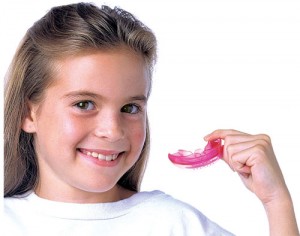
An incorrect bite in a child is an abnormality in the development of the dentition.
Malocclusion in children, according to statistics, is 90% of cases.
Among them, 10-15% of children who have serious malocclusion, and therefore, the intervention of an orthodontist is simply necessary.
Parents of most children often do not pay attention to the problem of their child and turn to the dentist only for aesthetic assistance.
Causes
The formation of a malocclusion in a child can occur for various reasons, and many factors can influence its development.
Improper bite in children can develop for the following reasons:
- Genetic predisposition to the development of malocclusion. It plays an almost paramount role, therefore, it is very important that at the age of a child from three to five years, a visit to an orthodontist be held.
- The presence of children's bad habits: sucking a dummy, fingers, various toys and any items contributes to the development of a malocclusion in a child.
- Children are predisposed to the development of malocclusion, whose milk teeth are very close to each other. Permanent teeth require more space and are larger than milk teeth.
- The predominance in the diet of a child, mainly soft food.
The risk group includes children:
- Whose parents also suffer from malocclusion.
- With a violation of nasal breathing - children suffering from ENT diseases (the child has adenoids), allergies, etc.
- The development of malocclusion is often associated with the lack of natural feeding of the child, the use of nipples for feeding and soothers.
- With pathology of the spine and impaired posture.
- With the presence of systemic diseases (diabetes mellitus, pathology of the nervous system).
Symptoms
Signs of malocclusion in a child are:
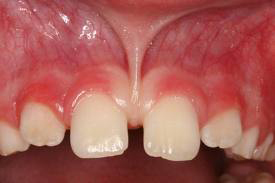
- Changing the position of the teeth, rotation around the axis.
- The presence of gaps between the teeth.
- Irregularities in the dentition.
- Extension of teeth in the front or rear direction.
- Violation of the jaw when closing teeth.
Types of Anomalies
Among the malocclusion anomalies are the following:
- Open bite. For this anomaly is characteristic not the closure of a group of teeth with central occlusion. A common sight is the anterior open bite, rather than in the region of the posterior teeth on two or one side.
- Mesial bite. A very common deformation, which is characterized by the advancement of the lower jaw relative to the upper.
- Distal bite. It is characterized by hyperdevelopment of the upper jaw, or underdevelopment of the lower jaw. The upper dentition is advanced forward relative to the lower group of teeth.
- Cross bite.There is an asymmetry of the face. One of the jaws is narrower, while the lower jaw is shifted to the right or left. An anomaly can be either unilateral or bilateral.
- Deep bite. At the moment of jaw closure, the upper jaw overlaps the lower jaw by more than a third.
- Diastema. It manifests itself in the form of the presence of a wide gap (width from 1 to 6 mm) between the central incisors of the upper or lower dentition. In the upper row of teeth, anomaly is more common than in the lower.
Video: “How to align crooked teeth? How to correct a child’s bite? No braces! ”
When to start treatment
- The presence of malocclusion is one such problem that can be solved if treatment is started before the child reaches the age of five.
- If the correction of the anomaly is not started on time, then the presence of maxillofacial defects, which are associated with the development of a malocclusion, can subsequently cause respiratory and digestive system diseases.
- In addition, in the presence of a malocclusion, problems often arise not only with teeth, but also with gums. As a result, the risk of caries increases, periodontal disease develops, crunching, clicks and pain in the temporomandibular joint appear. Often, tooth loss occurs.
- With an early visit to the doctor, the problem can be eliminated with the help of removable equipment that stimulates the growth of the jaw bones and corrects the work of muscles. For occlusion correction in older children, fixed constructions are used because we are already talking about the formed anomalies. Moreover, in the adult state, it is possible to correct the anomaly of the development of the jaw bones only by surgical intervention.
Bite Correction
The process of bite correction in children is complex and lengthy. It is impossible to correct a child’s bite independently.
Therefore, the baby must be shown to the orthodontist before the child turns 1, 2 or 3 years old.
Already at this age, an experienced dentist will be able to make a prognosis for a bite, and if necessary, take measures to prevent developmental anomalies.
- To prevent malocclusion anomalies, a very small child may be recommended to use a special nipple that will separate the tongue from the teeth.
- For the treatment of malocclusion in a child, most often, removable plates are used that perform various functions, depending on the cause of the anomaly.
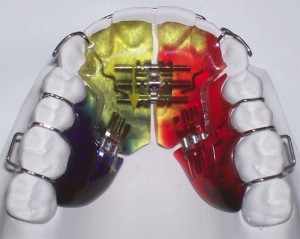
Photo: Removable teeth alignment plates - These can be plates that prevent the development of bad habits, for solving logopedic problems (if the child has a speech disorder), for expanding the dentition, etc.
- Among the soft structures designed to correct the anomaly are LM - activators and trainers, which are more suitable for correcting the bite for children aged 7-12 years.
- At the age of 10-12 years, full or partial braces are installed. Correction of anomalies with the help of bracket systems can last from six months to two years or more.
Why it is necessary to start treatment at an early age
The reasons for correcting the bite in children under 5 years old are many:
- The development of malocclusion has a negative effect on both the health of the teeth and the entire body.
- Correcting the developmental anomaly in children is much easier and faster than in an adult.
- A child is much lighter than an adult tolerates the presence of orthodontic appliances in the oral cavity.
- It is impossible to correct the development of the jaw in an adult.
Photo: before and after
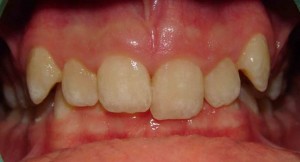 |
 |
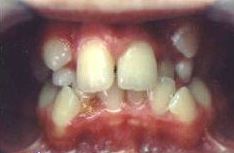 |
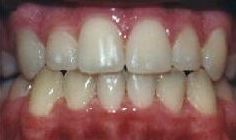 |
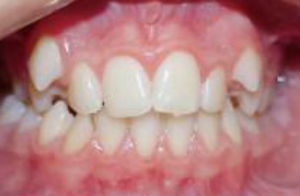 |
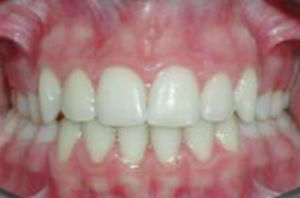 |